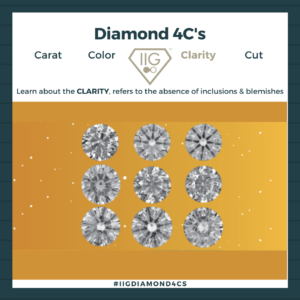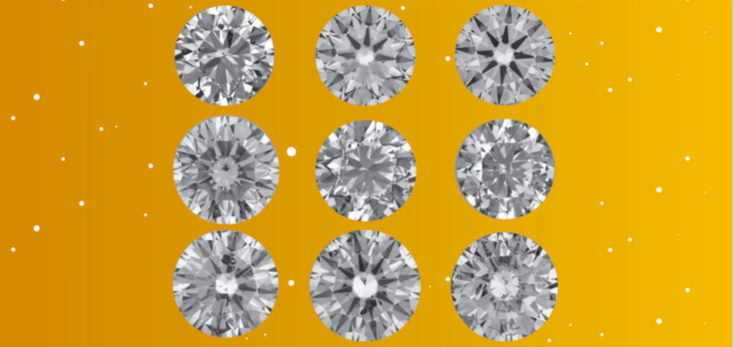|
Getting your Trinity Audio player ready...
|
Clarity simply means examining a diamond in a systematic way, recognizing its clarity characteristics, and deciding its visibility and impact. The important and the visibility of inclusion determine the clarity of a diamond the reasons why some diamonds are more valuable than others, is that they are rarer, they contain less inclusion and/or the impurities have a better location, and/or the color of the inclusion is less marked and as far as the inclusion is not too big and the life of the diamond is not weakened.
The larger the inclusion or number of inclusion the lower the grade and the value of a diamond. The finest clarity grade is flawless (FL) and internally flawless (IF) and goes down to heavily included (I3)
Clarity Characteristics
Before you determine a characteristic’s impact on clarity, you must identify it. This section describes the types of characteristics present in a diamond, their appearances and ways to identify them.
Clarity characteristics are classified as inclusions and blemishes :
Inclusions: Characteristics that are totally enclosed within the diamond (internal inclusions) or that extend into the diamond from its surface, with visible depth at 10X magnification (surface-reaching inclusions).
Blemishes: Characteristics that are confined to the diamond’s surface and have no visible depth at 10X magnification.
Different kinds of diamond Inclusions:
Not all diamond inclusions are the same. Of course, they can differ in size, shape, and location. But there are actually many different kinds of inclusions:
- Feather
- Knot
- Pinpoint
- Group of pinpoints / Cloud
- Cavity
And finally, there are also man-made inclusions, such as:
- Laser drill hole
- Bearded girdle
- Percussion mark
Different kinds of diamond Blemishes:
- Abrasion
- Scratches
- Nick / Pit
- Polish Lines
- Polish Marks (Burn)
- Rough Girdle
- Natural
- Surface Graining
Clarity Grading: Steps to follow
A certain procedure is to be followed for grading clarity accurately. This involves a step-by-step clarity grading.
- Clean the stone thoroughly with a lint-free cloth.
- Examine the stone face-up under a fully corrected 10x magnification (Dark-field illumination for inclusions and Reflected light for blemishes).
- Note your first impression of the severity of the inclusions. This usually establishes the stone’s clarity range.
- Examine the stone from the profile view, around the girdle, and from the side (through both crown and pavilion facets). Note all the characteristics taking into account the five factors: size, nature, position, relief or color, and the number of inclusions to judge the impact of these impurities.
- Review the stone face-up, assign general clarity classifications. If using a microscope, recheck for dark inclusions with a loupe.
- Make distinctions between VVS1-VVS2, VS1-VS2, SI1-SI2- and I1-I2- I3 Use the definitions plus the five factors as a guide.
- Call the clarity grade.
- Plot the stone.
- Reconfirm on all inclusions and blemishes after plotting with a 10x loupe.
- Call the grade.
Introduction to the International Grading System
The International Diamond Grading Standards comprise a set of methods, terms, and norms for determining and describing the 4 C’s of a Diamond- Clarity, Color, Cut, and Carat weight.
The gemological microscope locates and plots inclusions and blemishes. However, the clarity grade is called on the basis of the impact of the impurities under a 10X loupe as the diamond industry goes by the 10X for calling clarity grades.
International Clarity Grading Scale
Flawless Grade (FL) is used to describe diamonds in which a skilled observer, under favorable lighting conditions, cannot see any inclusions or surface blemishes, after a thorough examination with a binocular microscope at ten power magnification or with a 10X corrected loupe. Small extra facets on the pavilion near the girdle, not visible when viewed from the crown, are permitted as are small naturals when they are confined to the girdle outline. Internal graining is permitted provided it does not draw any color or texture and is not observable through the crown.
Internally Flawless (IF) describes diamonds which have no internal characteristics observable under the same conditions as described, but which have minor surface blemishes that do not penetrate the stone. Surface grain lines are permitted provided they are not too thick or numerous so as to detract from the beauty of the stone. Internal graining is permitted, provided it does not draw color or texture.
VVS 1 & VVS 2 (Very Very Slightly Included) are used to describe diamonds that have very, very small inclusions which are difficult for a skilled observer to see under the conditions as described. Colored or textured graining is permitted, provided it is not observable through the crown.
VS 1 & VS 2 (Very Slightly Included) are used to describe those stones with very small inclusions which are difficult to observe under the conditions as described. Except for larger stones or occasionally with emerald cut diamonds, these are rarely visible to the unaided eye.
SI1, SI2 & SI3 (Slightly Included) are used to describe stones with small inclusions which are usually obvious when viewed under the described conditions. Stones in these graded may sometimes have inclusions which are difficult to see with the unaided eye.
I1, I2 & I3 (Included) are used to describe stones with medium to large inclusions (Piques) which are usually obvious to a skilled observer with the unaided eye under favorable lighting conditions.
Every diamond is unique – with its own series of internal and external characteristics. The skilled grader takes into consideration the size, nature, location, relief, and the number of these characteristics to assign each stone its proper grade.



